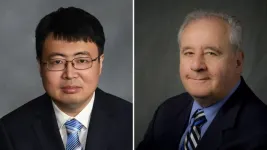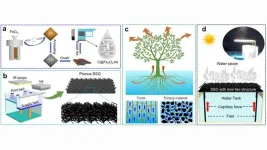(Press-News.org) Psychologists have used the hit TV series Game of Thrones to understand how the brain enables us to recognise faces.
Their findings provide new insights into prosopagnosia or face blindness, a condition that impairs facial recognition and affects approximately 1 in 50 people.
The researchers scanned the brains of over 70 study participants as they watched footage from the popular TV series. Half of the participants were familiar with the show’s famously complex lead characters and the other half had never seen the series.
When lead characters appeared on screen, MRI scans showed that in neurotypical participants who were familiar with the characters, brain activity increased in regions of the brain associated with non visual knowledge about the characters, such as who they are and what we know about them. Interestingly, connections between the visual brain and these non-visual regions were also increased in people who were familiar with Game of Thrones. However, these waves of activity were significantly reduced in the group of neurotypical participants who had never watched the series.
To determine whether these regions are important for face recognition, the researchers then repeated the study in people with prosopagnosia. As with the previous group, half had watched Game of Thrones and half had never seen the series. Consistent with their difficulty in recognising faces, the effect of familiarity was not found in the same regions of the brain found in neurotypical participants. The connections between the visual and non-visual regions were also reduced in face blindness.
Senior author of the study, Professor Tim Andrews from the Department of Psychology, said: “We were really excited to see the results of our study as they suggest that our ability to recognise faces relies on what we know about people, not just what they look like.”
"While it was believed that we recognise faces by learning their visual properties—such as features, configuration, and texture—our study indicates that it involves connecting a face with knowledge about the person, including their character traits, body language, our personal experiences with them, and our feelings towards them.
"Facial recognition is essential for daily life and social interactions. When people struggle with this, it can significantly impact their lives and relationships, often leading to mental health issues and social anxiety.
“Our research enhances the understanding of how prosopagnosia appears to be linked to reduced neural connections, making it challenging to associate faces with personal knowledge, which is crucial for recognition.”
The researchers chose to show participants footage from Game of Thrones because of its international appeal and the multitude of well-developed lead characters.
Lead author of the study and PhD student in the Department of Psychology, Kira Noad, said: “We chose to show participants footage from Game of Thrones because the series captivated people around the world with its strong characters and their deeply nuanced personalities.
“Many previous studies on the mechanisms in the brain behind facial recognition have been done in laboratory settings with 2D static images of faces. We aimed to create a study format that was more like real life, using video to show complex scenes with multiple people.
“We now need to carry out further studies to explore in more detail how activity across different regions of the brain allows us to recognise faces as well as what factors can disrupt this process.”
'Familiarity enhances functional connectivity between visual and non-visual regions of the brain during natural viewing' is published in the journal Cerebral Cortex.
END
Study uses Game of Thrones to advance understanding of face blindness
2024-07-23
ELSE PRESS RELEASES FROM THIS DATE:
OptoGPT: building foundation models for multilayer thin film design
2024-07-23
A new publication from Opto-Electronic Advances; DOI 10.29026/oea.2024.240062, discusses OptoGPT, a new inverse design algorithm.
Optical multilayer thin film structure is one of the most important photonic structures widely used in many applications, including color filters, absorbers, optical cavities or resonators, photovoltaic and radiative cooling, special mirrors for extreme UV lithography and for space telescopes. Designing these structures requires much training and expertise as identifying the best combination of materials and the thickness at ...
Finding a solution for long COVID, one cell type at a time
2024-07-23
COLUMBUS, Ohio – A 2022 study suggesting that blocking a single molecule could protect against severe illness in COVID-19 has led to a $15 million federal grant supporting a comprehensive effort to learn more – with finding a solution to long COVID at the center of the new research.
Since that study’s publication, scientists at The Ohio State University have been exploring how the SARS-CoV-2 virus that causes COVID-19 prompts this human molecule’s destructive activity, and outlined the series of steps needed to fully describe what’s ...
An isolated viral load test may generate false positive results for people using long-acting PrEP
2024-07-23
A single laboratory-based HIV viral load test used by U.S. clinicians who provide people with long-acting, injectable cabotegravir (CAB-LA) HIV pre-exposure prophylaxis (PrEP) did not reliably detect HIV in a multi-country study. In the study, a single positive viral load test was frequently found to be a false positive result. However, a second viral load test with a new blood sample was able to distinguish true positive results from false positive results for all participants whose initial viral load test was positive. The findings were presented at the 2024 International AIDS Conference (AIDS 2024) ...
Microwave popcorn to particle accelerators: magnetrons show promise as radiofrequency source
2024-07-23
NEWPORT NEWS, VA - A pocket-size gizmo that puts the “pop” in microwave popcorn could soon fuel particle accelerators of the future.
The small but mighty device is a magnetron – a mashup of the words “magnetic” and “electron.” The term was coined in 1921, and the technology was once a wartime secret before making its way into billions of homes as the heart of the modern microwave oven.
Now, physicists and engineers at the U.S. Department of Energy’s Thomas ...
New research identifies less invasive method for examining brain activity following traumatic brain injury
2024-07-23
Johns Hopkins Medicine researchers have published new research that reports on a potential alternative and less-invasive approach to measure intracranial pressure (ICP) in patients.
This research was published July 12 in the journal Computers in Biology and Medicine.
ICP is a physiological variable that can increase abnormally when one has acute brain injury, stroke or obstruction to the flow of cerebrospinal fluid. Symptoms of elevated ICP may include headaches, blurred vision, vomiting, changes in behavior and decreased level of consciousness. ...
Prostate cancer blood test equally effective across ethnic groups
2024-07-23
Stockholm3, a prostate cancer test developed in Sweden, runs a combination of protein and genetic markers from a blood sample through an algorithm to find the probability of a patient having clinically significant cancer.
Studies in more than 90,000 men have shown that Stockholm3 produces significantly better results than the current PSA standard. The test improves prostate cancer diagnosis by reducing unnecessary MRI and biopsies and by identifying significant cancers in men with low or normal PSA values.
However, previous studies have been conducted primarily in Scandinavia ...
Lehigh University team wins 2024 Alfred Noble Prize for work on optimizing bridge maintenance
2024-07-23
Lehigh University structural engineering alum Xu Han ’23 PhD and his doctoral advisor Professor Dan M. Frangopol have been awarded the 2024 Alfred Noble Prize, an esteemed interdisciplinary award from a consortium of professional societies, administered by the American Society of Civil Engineers (ASCE).
“I feel very humbled for receiving such a prestigious award and am very grateful to people nominating me,” says Han, who is now a postdoctoral research fellow at Texas A&M University.
Frangopol, Lehigh’s inaugural Fazlur R. Khan Endowed Chair of Structural Engineering and Architecture, is a world-renowned expert ...
3D-printed microstructure forest facilitates solar steam generator desalination
2024-07-23
WASHINGTON, July 23, 2024 — Faced with the world’s impending freshwater scarcity, a team of researchers in Singapore turned to solar steam generators (SSGs), which are emerging as a promising device for seawater desalination. Desalination can be a costly, energy-intensive solution to water scarcity. This renewable-powered approach mimics the natural water cycle by using the sun’s energy to evaporate and isolate water. However, the technology is limited by the need to fabricate complex topologies to increase the surface area necessary to achieve high water evaporation efficiency.
To overcome this ...
Wearable sensors help athletes achieve greater performance
2024-07-23
WASHINGTON, July 23, 2024 – Today’s athletes are always on the lookout for new techniques and equipment to help them train more effectively. Modern coaches and sports trainers use intelligent data monitoring through videos and wearable sensors to help enhance athletic conditioning. However, traditional video analysis and wearable sensor technologies often fall short when tasked to produce a comprehensive picture of an athlete’s performance.
In APL Materials, by AIP Publishing, researchers from Lyuliang University developed ...
Gender differences in electronic health record usage among surgeons
2024-07-23
About The Study: This cross-sectional study of electronic health record (EHR) data found that female surgeons spent more time documenting patient encounters, wrote longer notes, and spent more time in the EHR system compared with male surgeons. These findings have important implications for understanding the differential burdens faced by female surgeons, including potential contributions to burnout and payment disparities.
Corresponding Author: To contact the corresponding author, Corinna Zygourakis, ...





